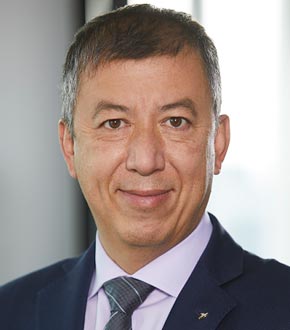Interview with Patrick KY
Director of EASA
How does regulation help to control the risks associated with the major challenges facing the airline industry?
We ensure that issues such as innovation, the environment and recruitment have no impact on safety.
As regulations cannot be adapted in real time to new risks, our role is to establish sufficiently broad bases to ensure that safety levels are respected, if not increased. With regard to cybersecurity, for example, we are not seeking to issue prescriptive rules, but to ensure that the subject is taken into account in risk management, throughout the chain of service providers involved in aviation. This involves constant dialogue with industry representatives, who are involved in drafting our regulations.
Safety rules have an impact on security rules, and vice versa. What is the purpose of the study launched by EASA on this subject?
At the beginning of 2023, we asked the consortium formed by Apave Aeroservices to conduct a study into these reciprocal influences, which are manifold. In aviation, there are many niches of expertise, and each is quite jealous of its prerogatives. It is up to EASA to ensure that no safety initiative poses a problem in terms of security, and vice versa. This study will give us a clearer picture.
How is Europe positioning itself in relation to emerging markets such as China and India?
Europe remains at the forefront of technological innovation and the environmental approach to aviation. The European Union has just adopted a regulation requiring the increasing use of sustainable fuels in aircraft. It is the first to do so. In the short term, the emerging countries are not changing the game for us. But they will, the day they produce their own aircraft.
"Europe is at the forefront of innovation and the environment".
Can safety rules be compatible with the new ecological requirements?
EASA's mandate is clear: no environmental initiative should have an impact on safety. The difficulty lies in the fact that the fight against climate change includes players outside aviation, such as producers of sustainable fuels or hydrogen. It's up to us to work with them to keep a firm grip on our future, which is bound to be green.
 Download The Bourget Magazine
Download The Bourget Magazine
EASA

The European Union Aviation Safety Agency (EASA) is responsible for ensuring the safety and environmental protection of air transport in Europe.
EASA's missions are to:
- - Harmonise regulations and issue certifications
- - Develop the EU's single air transport market
- - To draw up technical rules in the field of aviation
- - Issue type approvals for aircraft and components
- - Approving companies that design, manufacture and maintain aeronautical products
- - Overseeing safety and providing support to EU countries
- - Promote European and global safety standards
- - Work with international players to improve safety in Europe
Measuring the impact of safety on security
A consortium...
At the beginning of the year, the European Union Aviation Safety Agency (EASA) commissioned a consortium to carry out a 36-month study on the interactions between safety and security in air transport. The consortium includes Apave Aeroservices, a provider of consultancy services, safety audits and training, CAA International, the consultancy arm of the UK Civil Aviation Authority, and the Swiss company CASRA (Center for Adaptive Security Research and Applications).
... and a study
This is the first time that the desire to analyse the impact of security measures, laws and regulations on aviation safety, and vice versa, has been expressed at such a high level. The air transport industry is seeking to consolidate its risk management, moving away from a silo-based approach (Quality, HR, Commercial Services, Maintenance, Flight Operations, etc.) towards a more systemic, interface-oriented approach, so as to gain a better grasp of the risks in the air transport ecosystem.
Apave at the Paris Air Show 2023
Apave and all its subsidiaries will be on stand B163 in Hall 2.
Apave will also be welcoming its customers to its chalet at the foot of the slopes.
Discover the programme:
Our other
news

